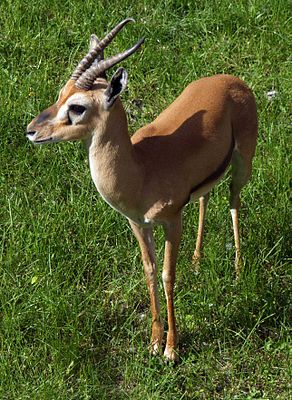Red-fronted Gazelle
| Red-fronted Gazelle | ||||||||||||
|---|---|---|---|---|---|---|---|---|---|---|---|---|

Red- fronted Gazelle ( Eudorcas rufifrons ) |
||||||||||||
| Systematics | ||||||||||||
|
||||||||||||
| Scientific name | ||||||||||||
| Eudorcas rufifrons | ||||||||||||
| ( Gray , 1846) |
The red-fronted gazelle ( Eudorcas rufifrons , syn .: Gazella rufifrons ) is a type of gazelle that is particularly common in the African Sahel . Sometimes the Thomsonian gazelle and the Mongalla gazelle are considered subspecies of the red-fronted gazelle.
features
The red-fronted gazelle is a medium-sized gazelle with dark flank stripes. This is narrower than the similar Thomson gazelle. This gazelle reaches a shoulder height of up to 68 centimeters and weighs up to 30 kilograms. In addition to the head-trunk length of 90 to 110 cm, there is a 20 to 30 cm long tail. The horns, which both sexes grow, grow up to 34 inches long. The fur of the red-forehead gazelle is brownish on the top and lighter to whitish on the underside. The reddish center of the face is delimited by two more or less distinct white stripes that extend from the eyes to the corners of the mouth. Sometimes these are followed by black stripes below.
Distribution area
The red-fronted gazelle inhabits the dry grass and shrub steppes of the Sahel zone and adjacent parts of geographic Sudan . The species is essentially restricted to areas west of the Nile, only one subspecies, the Heuglingazelle ( E. r. Tilonura ), occurs east of the Nile.
A distinction is made between the following subspecies:
- E. r. rufifrons : Western Sahel
- E. r. laevipes : Eastern Sahel zone
- E. r. kanuri : south of Lake Chad
- E. r. tilonura : Eritrea, Sudan
Occasionally be Thomson's Gazelle ( Eudorcas thomsoni ) and the mongalla gazelle ( Eudorcas albonotata ) also considered a subspecies of red-fronted gazelle.
Way of life
The individuals live either individually, as a pair or in small groups with generally less than 6 specimens, even if herds of 15 specimens have already been observed. The red-fronted gazelle mainly eats grass and, to a lesser extent, leaves. It approaches the Sahara in the rainy season and retreats at the beginning of the dry season. The population density is comparatively low with 0.3 to 0.7 individuals per km². Usually the gestation period is around 185 days. The young are thought to be suckled for three months. Specimens in human care could live up to 14.5 years.
Danger
The red-fronted gazelle is threatened by hunting and overgrazing of their habitats. Parts of the stock are protected in larger protected areas, such as W National Park and Waza National Park. The subspecies Heuglingazelle ( E. r. Tilonura ) occurs in the Dinder National Park in Sudan, where protection is hardly guaranteed. A certain number of red-fronted gazelles are also bred in captivity. The species is classified as endangered ( Vulnerable ) by the IUCN .
literature
- CA Spinage: The Natural History of Antelopes . Croom Helm, London 1986, ISBN 0-7099-4441-1 .
- Jonathan Kingdon: The Kingdon Field Guide to African Mammals . Academic Press, San Diego, London, 1997. ISBN 0-12-408355-2 .
Individual evidence
- ↑ Spigane, p 191
- ↑ a b Brent Huffman: Red-fronted gazelle ( Engl. ) In: Ultimateungulate . October 13, 2011. Retrieved November 15, 2011.
- ↑ a b Kingdon, 1997 (pp. 411-412)
- ↑ a b c Eudorcas rufifrons in the endangered Red List species the IUCN 2011. Posted by: IUCN SSC Antelope Specialist Group, 2008. Accessed on 18 July 2011th